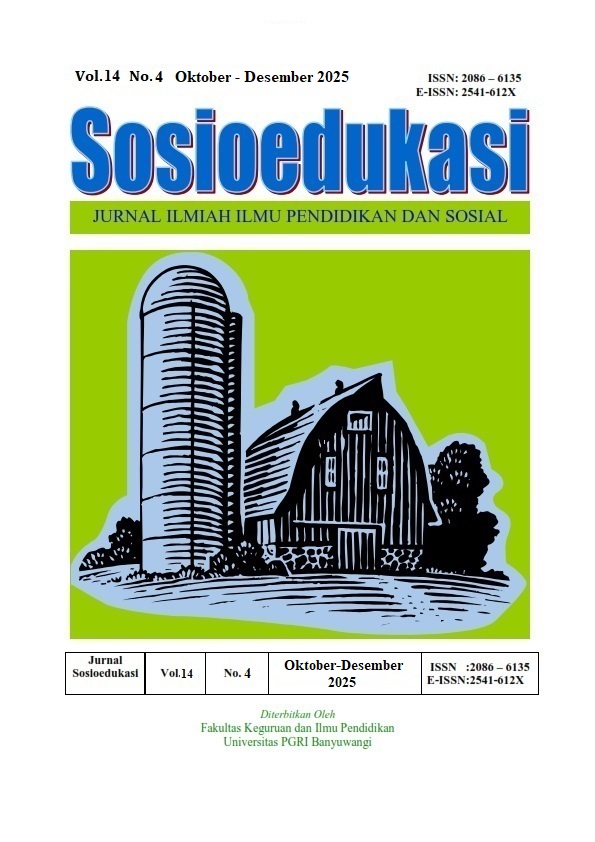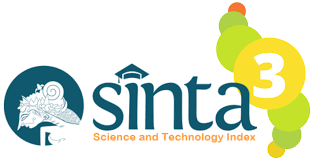DIGITAL STORY TELLING: STUDENTS’ PERCEPTION IN DEVELOPING DESCRIPTIVE WRITING ABILITY
DOI:
https://doi.org/10.36526/sosioedukasi.v14i4.6289Keywords:
Digital Story Telling (DST) Students’ Perception Descriptive WritingAbstract
This study is exploring the students’ perception in developing descriptive writing ability trough digital story telling in university students. This study is exploring university students’ perception when they developing their writing especially descriptive text using digital story telling media. The students’ perception is affected how their attitude during activity when they develop their writing ability towards digital story telling media. This study involves 23 participants taken from some classes in English education students which they already practice their descriptive writing using digital story media. This study utilizes a survey using adapted questionnaire and interviews to gather information about the students’ perception regarding their attitude while develop their descriptive writing using digital story telling media. then analysed using likers scale for questionnaire using the formula P = F/N × 100%, and data analysis of interview will be used systematically coded, in which specific statements are analysed and categorized into themes that reflect the phenomenon under investigation. The result of questionnaire shows that almost 80% students give positive perception in digital story telling as media in develop descriptive writing and the result of interview shows that the average students response stated that 75% of students has good perception about digital story telling used in descriptive writing then 25% is neutral. Based on both questionnaire and interview result we can concluded that digital storytelling gives positive perception in developing descriptive writing ability.
References
Bhakti, S. & Marwanto. (2020). Students’ perception on the digital storytelling implementation on developing the writing skills. Jurnal Bahasa Inggris Terapan, 6(2), 66–74. https://doi.org/10.35313/jbit.v6i2.2046
Choo, Y. B., Abdullah, T., & Mohd. Nawi, A. (2020). Digital storytelling vs. oral storytelling: an analysis of the art of telling stories now and then. http://eprints.utm.my/90912/
Creswell, J. W. (2017). Qualitative inquiry and research design: Choosing among five approaches (4th ed.). Sage Publications. Available at: https://us.sagepub.com/en-us/nam/qualitative-inquiry-and-research-design/book258244
Creswell, J. W. (2014). Research design: Qualitative, quantitative, and mixed methods approaches (4th ed.). Sage Publications. Available at: https://us.sagepub.com/en-us/nam/research-design/book237401
Etikan, I., Musa, S. A., & Alkassim, R. S. (2016). Comparison of convenience sampling and purposive sampling.American Journal of Theoretical and Applied Statistics, 5(1), 1–4. https://doi.org/10.11648/j.ajtas.20160501.11
Gómez-Rodríguez, C., Christiansen, M. H., & Ferrer-i-Cancho, R. (2019). Memory limitations are hidden in grammar. arXiv preprint arXiv:1908.06629. https://arxiv.org/abs/1908.06629
Pekrun, R., Loderer, K., & Perry, R. P. (2020). Control–Value Theory of achievement emotions: Recent advances and future directions. Educational Psychology Review, 32(2), 353–389. https://doi.org/10.1007/s10648-020-09585-0
Hyland, K. (2019). Second language writing (2nd ed.). Cambridge University Press.
Kane, T. S. (2010). The Oxford essential guide to writing. Oxford University Press.
Lambert, J. (2013). Digital Storytelling Capturing Lives, Creating Community (4th Editio). Center for Digital Storytelling ROUTLEDGE.
Min, T. (2022). Develop digital storytelling integrates with animation as an innovative instructional tool: effects on student’s behavioural engagement in learning. Statistika, Učet I Audit, 84(1), 35-38. https://doi.org/10.51579/1563-2415.2022-1.02
Oshima, A., & Hogue, A. (2017). Introduction to academic writing (3rd ed.). Pearson Longman.
Pekrun, R. (2020). The control–value theory of achievement emotions: Assumptions, corollaries, and implications for educational research and practice. Educational Psychology Review, 18(4), 315–341. https://doi.org/10.1007/s10648-006-9029-9
Ramalia, T. (2023). Digital Storytelling in Higher Education: Highliting the Making Process. Journal on Education; Vol 6 No 1 (2023): Journal On Education: Volume 6 Nomor 1 Tahun 2023; 7307-7319 ; 2654-5497 ; 2655-1365 ; 10.31004/Joe.V6i1. http://jonedu.org/index.php/joe/article/view/3993
Shemy (2023). Persepsi pengalaman DST, motivasi belajar, efektivitas pedagogis. https://www.ijiet.org/vol13/IJIET-V13N9-1947.pdf?utm_source=chatgpt.com
Sugiyono. (2019). Statistika untuk penelitian (3rd ed.). Alfabeta. Available at: https://www.academia.edu/39549384/Statistika_untuk_Penelitian_Prof_Sugiyono.
Wigfield, A., & Eccles, J. S. (2020). 35 years of research on students’ subjective task values and motivation: A new look at Expectancy–Value Theory. Contemporary Educational Psychology, 61, 101859. https://doi.org/10.1016/j.cedpsych.2020.101859
Yang, Y.-T. C., Chen, Y.-C., & Hung, H.-T. (2020). Digital storytelling as an interdisciplinary project to improve students’ English speaking and creative thinking. Computer Assisted Language Learning. https://doi.org/10.1080/09588221.2020.1750431
Zhou, M., & Wang, J. (2023). Expectancy–Value Theory in technology-enhanced learning: Understanding students’ perceptions of value and cost in adopting educational technology. arXiv preprint arXiv:2305.01186. https://arxiv.org/abs/2305.01186









.png)

















